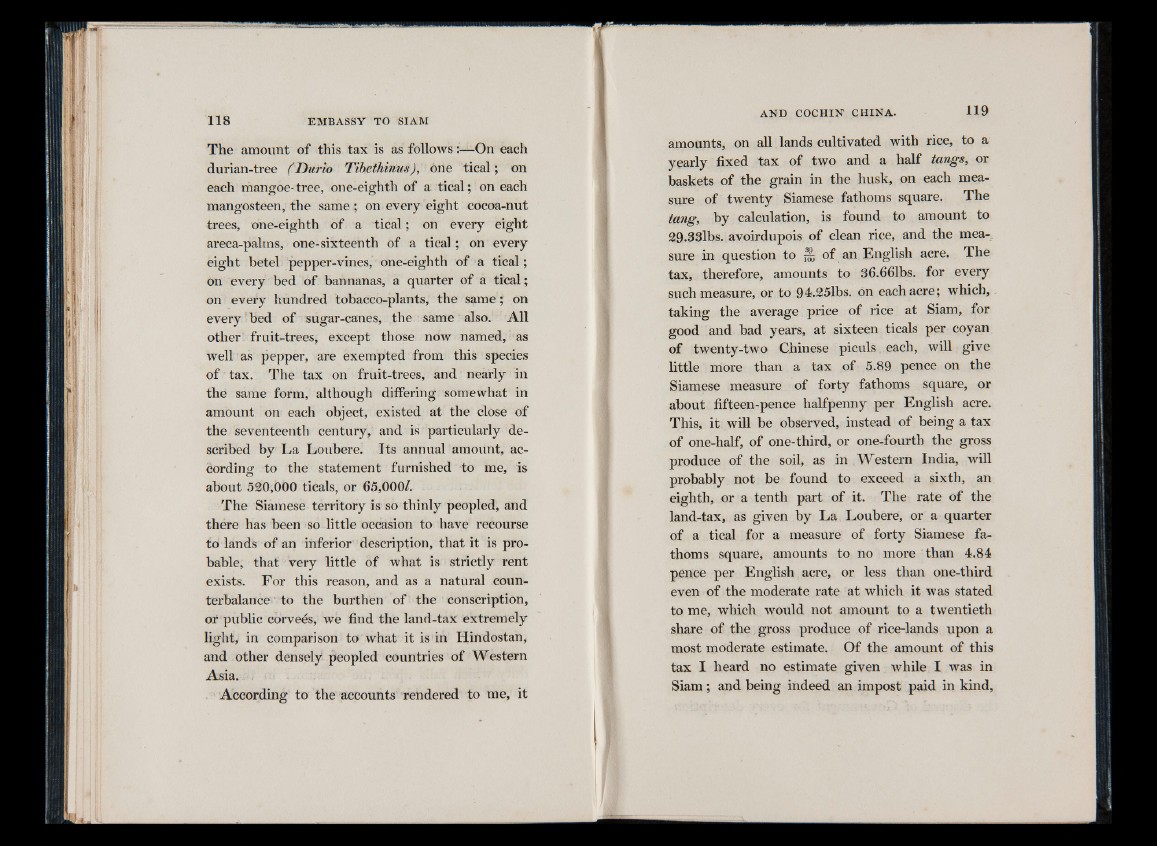
The amount of this tax is as follows:—On each
durian-tree (Durio Tibethinus), one tic a l; on
each mangoe-tree, one-eighth of a tical; on each
mangosteen, the same ; on every eight cocoa-nut
trees, one-eighth of a tic al; on every eight
areca-palins, one-sixteenth of a tical; on every
eight betel pepper-vines, one-eighth of a tical;
on every bed of bannanas, a quarter of a tical;
on every hundred tobacco-plants, the same; on
every bed of sugar-canes, the same also. All
other fruit-trees, except those now named, as
well as pepper, are exempted from this species
of tax. The tax on fruit-trees, and nearly in
the same form, although differing somewhat in
amount on each object, existed at the close of
the seventeenth century? and is particularly described
by La Loubere. Its annual amount, according
to the statement furnished to me, is
about 520,000 ticals, or 65,000/.
The Siamese territory is so thinly peopled, and
there has been so little occasion to have recourse
to lands of an inferior description, that it is probable,
that very little of what is strictly rent
exists. For this reason, and as a natural counterbalance‘
to the burthen of the conscription,
of public corveds, we find the land-tax extremely
light, in comparison to what it is in Hindostan,
and other densely peopled countries of Western
Asia.
According to the accounts rendered to me, it
amounts, on all lands cultivated with rice, to a
yearly fixed tax of two and a half tangs, or
baskets of the grain in the husk, on each measure
of twenty Siamese fathoms square. The
tang, by calculation, is found to amount to
29.33lbs. avoirdupois of clean rice, and the measure
in question to ^ of an English acre. The
tax, therefore, amounts to 36.661bs. for every
such measure, or to 94.25lbs. on each acre; which,
taking the average price of rice at Siam, for
good and bad years, at sixteen ticals per coy an
of twenty-two Chinese piculs each, will give
little more than a tax of 5.89 pence on the
Siamese measure of forty fathoms square, or
about fifteen-pence halfpenny per English acre.
This, it will be observed, instead of being a tax
of one-half, of one-third, or one-fourth the gross
produce of the soil, as in Western India, will
probably not be found to exceed a sixth, an
eighth, or a tenth part of it. The rate of the
land-tax, as given by La Loubere, or a quarter
of a tical for a measure of forty Siamese fathoms
square, amounts to no more than 4.84
pence per English acre, or less than one-third
even of the moderate rate at which it was stated
to me, which would not amount to a twentieth
share of the gross produce of rice-lands upon a
most moderate estimate. Of the amount of this
tax I heard no estimate given while I was in
Siam; and being indeed an impost paid in kind,